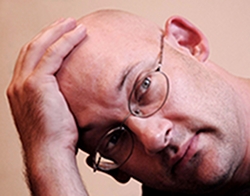
The Real Revolution Is Openness, Clay Shirky Tells Tech Leaders
Wired Campus, November 7, 2012, 9:29 pm
By Marc Parry
Denver — Clay Shirky is one of the country’s most prominent Internet thinkers—“a spiritual guide to the wired set,” as The Chronicle Review put it in a 2010 profile of him. In his latest book, Cognitive Surplus,the New York University professor argues that a flowering of creative production will arise as the Internet turns people “from consumers to collaborators.”
On Wednesday, Mr. Shirky took that message to a group of higher-education-technology leaders who have been buffeted by a rapidly evolving ed-tech landscape. Mr. Shirky, in a keynote speech kicking off this year’s Educause conference, explored how technology was changing everything, from research to publishing to studying. (The talk starts about 20 minutes into this link.)
Among his most vivid examples was the tale of the mathematician Timothy Gowers and the “quiet revolution” that began after Mr. Gowers posed a question on his blog: “Is massively collaborative mathematics possible?” This led to The Polymath Blog, Mr. Shirky said, an experiment in letting anyone participate in mathematical research, rather than confining it to individuals or small groups.
The big theme of Mr. Shirky’s talk was openness. Taking advantage of technology, he argued, will require “doing more sharing than we’re used to and then learning to live with results.” He underscored the power of sharing with an anecdote about what happened when the Smithsonian Institution made a cache of photographs available on Flickr, the photo-sharing site. Users catalogued the archive with tags that reflected an unpredictable range of interests, including facial hair, the history of photography, and the fiction genre known as Steampunk.
“There’s all kinds of hidden value in our systems which you can’t even understand until you open them up to see what people do with them,” Mr. Shirky said. “The thing that drives me craziest in conversations with large institutions about large data sets is they want to know in advance what will happen. Why should we open up our data? To which the answer is, you open up your data to see where the value is. It’s the value you can’t even predict until you try it that you get back.”
Mr. Shirky also offered some advice to people interested in experimenting with openness: “Do not put together an interdisciplinary team from 12 departments and give them a budget of a quarter of a million dollars, and a year and a half deadline. Find five people and ask them what can you do in a month—for free. I think the results will surprise you.”
See Also:
THE OPEN SOURCE EVERYTHING MANIFESTO: Transparency, Truth & Trust (paperback)
THE OPEN SOURCE EVERYTHING MANIFESTO: Transparency, Truth & Trust (Kindle)
Books on Intelligence & Information Operations by Robert David STEELE Vivas et al



